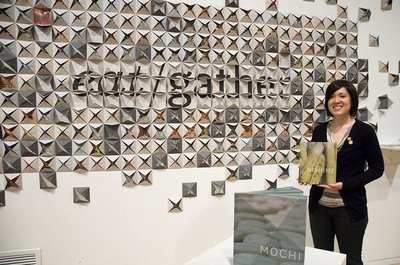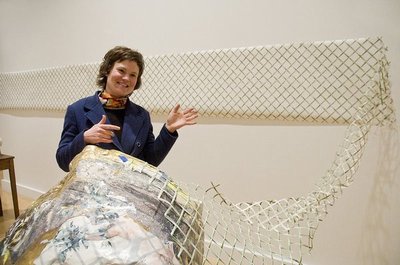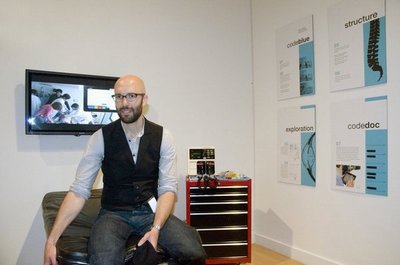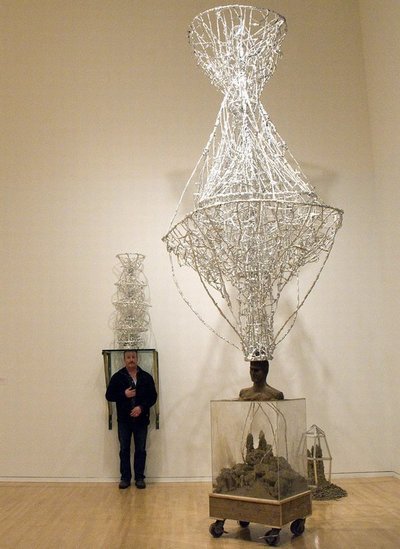June 3, 2010
Masters of art: Student art, design talents shine in Henry Art Gallery’s eclectic MFA Exhibition
From towering aluminum headgear to outsized stainless steel pillows, interactive note cards, posters promoting good social works and even a device to better document medical emergencies, there’s a lot to peruse and ponder at the annual MFA Thesis Exhibition, now open at the Henry Art Gallery.
Each year, the Henry hosts the thesis work of students earning their Masters of Fine Arts at the UW. As press notes state, “Throughout their program, students have worked with advisers and other artists to develop advanced techniques, expand concepts, discuss critical issues, and emerge with a vision and direction for their own work.”
The works in the exhibit were chosen by the artists in consultation with their thesis committees, and, as every year, Jim Rittimann, the Henry’s head preparator and exhibit designer, provided curatorial assistance.
The eclectic exhibit included examples both of art for art’s sake and more practical designs striving to solve real-world problems, from eight students in the School of Art’s Design Division. Rittimann said such designers have contributed to the MFA exhibit “on and off” through the years. “I think they show a different point of view and the Henry Art Gallery welcomes their participation. It gives the public a taste of all the programs that are offered in the School of Art.”
“My major is interaction design, and so in a lot of ways I don’t consider this art — though we share a lot with artists in the creative process,” said Kristofer Martin, creator of Medical Emergency Black Box Information System. Seated on a gurney in what could pass for a small medical clinic amid the art, Martin explained a bit more. “This is actually a partnership between design and the medical school where we are designing an application to document emergency treatment in a hospital.”
In an emergency, he said, a nurse must create a record of all the medications and treatments given a patient, a task of “nightmarish” difficulty. “What I’ve done is try to reorganize their process of documenting along a timeline in a software base that would live on a tablet, something like an iPad.” Martin, who started college in computer science before turning to the design world, said, “I think I am a creative problem solver. I like to think about how to translate human behavior into really smart interactive systems that can help people.”
“You are here,” state small buttons available alongside Benjamin Shown’s work, Nickelsville Map Project, which uses a variety of maps and “infographic posters” to show the viewer the history and location of homeless camps named for Seattle’s last mayor and to provide information on the causes of homelessness.
“I’ve always been concerned about homelessness issues, so I created this map from an information design standpoint and then developed it into these giant posters I put around the city in hopes of putting public pressure on (Seattle Mayor Mike) McGinn and the Seattle City Council to find a solution to the city’s homelessness problem.” (You can learn more about his work at online here.)
Artist Alanna MacGowan stands before a busy pattern of folded note cards on the wall that bear the message Eat / Gather. The cards invite viewers: “When you find a blank square, please feel free to stop by and share.” In front of these are books created by MacGowan “The whole project is centered around the books, which chronicle seasonal Japanese-American dishes as told by the second generation of Japanese Americans, which is my grandparents’ generation.”
MacGowan said, “I wanted it really to be something that was a jumping off point for a conversation about culture,” not only Japanese cuisine, “but wanting to broaden it to any audience, thinking about your own lineage and using food as a metaphor. The exhibition kind of functions as an open forum,” for people to come and be inspired by the cards, the books “or to come and read what other people have written.”
Somewhat less practical, perhaps, is artist Bryan Schoneman’s Communicating With the B Horizon, part of which is his crown of dirt. A performance artist, Schoneman said he builds this muddy headgear with clockwise motions and lets centrifugal force fly it apart when he spins in a counter-clockwise direction. He also has created different versions and sizes of intricately created aluminum foil headgear, which he is able to put on and (slowly, carefully, one assumes) walk around. He said he’s always been interested in the space from the crown of his head upward, and works with notions of “above” and “below” and the transitions in between. Soil scientists, he said, describe the “A” horizon as “the organic horizon, where things break down and turn into topsoil,” and the “B” horizon as the area between the organic horizon and bedrock.
Evren Artiran’s mixed-media installation piece, The Power of a Thing, comprises two parts: towering piles of colorful clothes on the one side and images of boxer shorts seemingly washed clean by the surf on the other. ‘My work is based on social conditions, social reality,” Artiran said. She has created pieces about earthquakes and the recent mine accidents, “and this piece came after those two pieces.” Of the tower of empty clothes, she added, “We consume people in the same way we consume objects.”
Lisa Rickey’s Reflections toys with notions of lightness and heaviness. It comprises shiny, pillow-shaped objects that look like they might be Mylar balloons but are in fact 16-gage stainless steel, filled with air at about 150 pounds per square inch, fused together and bolted to the floor. The piece was called Pillow Talk but Rickey changed it at the last minute. “It’s a lot about reflection, and about softness that is portrayed in a material that is not normally soft, this transformation.”
And then there is Alwyn O’Brien’s intriguing slip cast porcelain piece, complete with decals, wallpaper plaster and paint, titled Objects of Unknowing: Somewhere Between the Propped and the Picturesque. And Peter Nelson’s video piece Parents, which also gets acted out in real life. And Sam Payne’s Drawing Construction #2 (Shadow Boxing Compass), and Ren Sun’s extraordinary oil and watercolor paintings titled The Revelation of Himalayas. And Jason Foran’s huge Gyrecraft (see other creations of his in last week’s issue, here) and Gary Carpenter’s splintery cedar meditation on nature, Sequestered and Reconsidered.
A bit of something for most every taste — and then some — among this year’s crop of MFA art. The 2010 MFA Thesis Exhibition will remain at the Henry Art Gallery through June 27.






